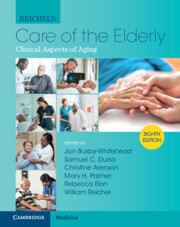Book contents
- Reichel’s Care of the Elderly
- Reichel’s Care of the Elderly
- Copyright page
- In Memoriam
- Contents
- Contributors
- Section I General Approach to the Care of the Elderly
- Chapter 1 Essential Principles in the Care of the Elderly
- Chapter 2 Biology of Aging
- Chapter 3 Comprehensive Geriatric Assessment
- Chapter 4 Screening and Prevention
- Chapter 5 Appropriate Use of Medications
- Chapter 6 Nutrition and Aging
- Chapter 7 Physical Activity and Exercise for Older Adults
- Section II Geriatric Syndromes
- Section III Care of the Elderly by Organ System
- Section IV Principles of Care for the Elderly
- Index
- Plate Section (PDF Only)
- References
Chapter 6 - Nutrition and Aging
from Section I - General Approach to the Care of the Elderly
Published online by Cambridge University Press: 30 June 2022
- Reichel’s Care of the Elderly
- Reichel’s Care of the Elderly
- Copyright page
- In Memoriam
- Contents
- Contributors
- Section I General Approach to the Care of the Elderly
- Chapter 1 Essential Principles in the Care of the Elderly
- Chapter 2 Biology of Aging
- Chapter 3 Comprehensive Geriatric Assessment
- Chapter 4 Screening and Prevention
- Chapter 5 Appropriate Use of Medications
- Chapter 6 Nutrition and Aging
- Chapter 7 Physical Activity and Exercise for Older Adults
- Section II Geriatric Syndromes
- Section III Care of the Elderly by Organ System
- Section IV Principles of Care for the Elderly
- Index
- Plate Section (PDF Only)
- References
Summary
Optimizing nutrition in the elderly is paramount to help maintain good health and quality of life. There are many factors leading to nutritional frailty in the elderly, including physiologic causes such as age-related changes in smell and taste, altered absorption in the gastrointestinal tract, changes in the neuroendocrine pathway, and cytokine-related adverse effects on nutrition. The burden of comorbidity, including cognitive decline, directly impacts an older adult’s nutritional status. Social factors such as limited access to fresh food, social isolation, and lower socioeconomic status can compromise an elderly individual’s nutritional status. It is important to screen the elderly for malnutrition in both the inpatient and outpatient setting using validated nutrition screening tools. The nutritional requirements of older adults are outlined in the U.S. Department of Agriculture (USDA) and the U.S. Departments of Health and Human Services (HHS) updated 2015-2020 Dietary Guidelines for Americans. The elderly in long-term care may face additional nutritional challenges including dysphagia due to a neurodegenerative process and perceived restrictions in mealtimes and menus. Nutritional frailty in the elderly is multifactorial and thus requires a multipronged approach to identification and management.
Keywords
- Type
- Chapter
- Information
- Reichel's Care of the ElderlyClinical Aspects of Aging, pp. 54 - 63Publisher: Cambridge University PressPrint publication year: 2022



